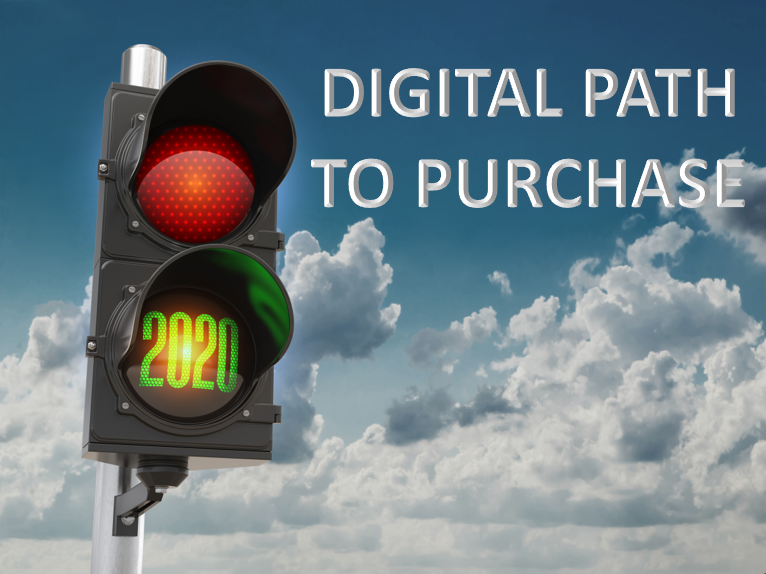Store closures and stay-at-home orders during the coronavirus pandemic forced most consumers to shop online. Daphne Howland (@daphnehowland) reports, “As stores were forced to close, digital sales were expected to take over. They’ve soared, but serious constraints are also now on display.”[1] As a result of increased ecommerce, the digital path to purchase has become a high street for retail sales. Megan Higgins (@Meg_HigginsCT), Vice President and General Manager of ecommerce and marketplaces at Avalara Inc., explains, “As the path to purchase becomes increasingly digital-first, retailers’ mobile and ecommerce capabilities are taking center stage within the retail experience.”[2] Mark Finch, Vice President of Sales for Europe, Middle East, and Africa at goMoxie, goes even further asserting retailers need to think digital to stay in business. He explains, “As bricks-and-mortar retailers scramble to remain current and successful in the digital age, businesses have come to realize they can no longer ignore their digital customers.”[3] Higgins agrees taking care of digital customers is essential. “Customer expectations of retailers have never been greater,” she writes. “As a result, leading retailers and marketplaces are turning to technology to optimize every step of a customer’s digital commerce journey.”
Ecommerce is accelerating on the digital high street
Thanks to the pandemic, Howland reports, “Consumers have gone online for even more shopping than usual, speeding up an existing trend. Digital revenue in April ‘far outpaced previous years and previous months,’ according to a report … by digital experience company Episerver. Traffic was up 30% year over year and 15% month over month; conversion rates were up 22% year over year and 18% month over month, with ‘nominal changes in discounting.’ And social media delivered, bringing 89% more traffic to retail sites compared to April 2019, according to that report.” She also notes that the rush of ecommerce traffic has not carried all retailers with it. In addition to sagging apparel sales, she reports, “Direct-to-consumer companies, including eyewear e-retailer Warby Parker and grooming brand Harry’s, in recent years have accepted that running physical stores or partnering with brick-and-mortar retailers are necessary methods of marketing to their customers. And several, including furniture pure player Wayfair and mostly online mattress brand Casper, have struggled to get into the black.”
The increase in online sales doesn’t necessarily doom physical stores. In fact, buy online and pick-up in store (BOPIS) strategies have proved popular with consumers. Such strategies, however, come at a cost for retailers. Nick Egelanian, president of SiteWorks, told Howland, “Retailers from grocery stores to Home Depot are seeing surging online orders and curbside pickup, but I doubt that any are making any real profits. Store employees spend hours walking store aisles filling orders inefficiently as consumers get the use of free personal shoppers. That’s not a sustainable formula.” As a result, Howland concludes, “E-commerce may be less than ideal for retailers, which must spend more to market to customers, fulfill orders and grapple with the channel’s larger number of returns.” It may be less than ideal, but on the digital path to purchase, the consumer rules. Higgins explains, “To deliver exceptional customer experiences at scale online, retailers must optimize each facet of their ecommerce operations, layering automation and intelligent technologies into each point of the digital journey.”
Five stages of the digital path to purchase
Higgins suggests there are five stages to the digital consumer journey. They are:
Stage 1. Shopper marketing and discovery. At this stage, Higgins writes, “Consumers expect their everyday online environments — from social feeds and mobile applications to wearables and home technologies — to serve as a conduit for shopping. To meet these demands, retailers rethinking their marketing strategies to become data-centric to understand and target customers in a personalized fashion effectively.” Cognitive technologies can help retailers understand their customers. For example, the Enterra Shopper Marketing and Consumer Insights Intelligence System™ can leverage all types of consumer data to provide high-dimensional consumer, retailer, and marketing insights.
Stage 2. ‘Store’ experience and design. “Once consumers make their way to your online store,” Higgins writes, “they expect to have the same experience as if they were in a physical store. The expectation is that retailers will virtually provide a mirror of in-store shopping experiences by incorporating adaptive and interactive technologies into their online storefronts.”
Stage 3. Shopper education and experience. “Similar to in-store engagements,” Higgins explains, “customers value brands that can assist them during their time shopping online. In fact, customers are willing to share information about themselves so that retailers will help them during their purchasing journey. One study found that 58% of millennials are willing to share their personal data to power product recommendations that best meet their needs. With predictive technologies that guide customer selections or real-time support online, retailers are rethinking how they can support and educate customers in the digital sphere.” Finch adds, “That means going beyond simply throwing product images on the web and adding a shopping cart. Being relevant starts with offering intuitive digital experiences that guide customers to success and save them time along the way.”
Stage 4. Transactions, payments, and tax. The rubber meets the road at checkout. Higgins explains, “Once customers have made their decisions on products, they expect that their seamless online experience will continue throughout the checkout process. Modern checkout processes should provide customers with ample payment options, automatically populate their payment information, accurately calculate any tax and shipping costs, and do all of this securely. With more than 87% of online shoppers abandoning their cart, checkout is complex, and the stakes are high for retailers.”
Stage 5. Fulfillment and post-purchase support. “For consumers,” Higgins writes, “the post-purchase experience is no longer an afterthought, but a crucial component of the customer experience. Customers expect near-instantaneous fulfillment, with delivery options that suit their lifestyles and a frictionless returns process.”
Finch concludes, “Instead of passively waiting for customers to figure out what they want, provide clarity and certainty through the purchase path. Anticipate their needs and offer useful information that answers a question before the customer even realizes they have one. Find common points of friction in the customer’s journey by looking at existing analytics tools and talking with sales agents about the questions customers most often ask. This kind of existing interaction data is invaluable for uncovering new opportunities for productive guidance.”
Concluding thoughts
As consumer behavior changes and the digital path becomes a high street and, eventually, a highway, retailers and consumers need to consider the best way to move forward. Howland notes, “E-commerce may be less than ideal for retailers, which must spend more to market to customers, fulfill orders and grapple with the channel’s larger number of returns.” Nevertheless, consumers like the convenience of shopping at home and having packages delivered to their doorstep. Howland explains such convenience comes at a cost. She notes there are “serious concerns about the environmental impact — from the excessive packaging to the need for delivery that clogs city traffic and spikes emissions.” Keith Anderson, Senior Vice President of Product Strategy and Insights at Profitero, told Howland, “E-commerce isn’t magic. That’s not a new idea, but the acknowledgment is new, and it’s shocking how quickly it’s been revealed. All of a sudden you have to acknowledge it. There’s a new focus on the supply chain, and the economics of e-commerce, and the environmental consequences.” Just as the Dwight D. Eisenhower National System of Interstate and Defense Highways changed the transportation sector forever, ecommerce is having a similar effect on the retail sector. The pandemic accelerated the move to ecommerce faster than solutions to constraints could be developed. Hopefully, retailers and supply chain experts will use lesson learned during the pandemic to work through the pain points they have discovered.
Footnotes
[1] Daphne Howland, “What the pandemic reveals about e-commerce,” Retail Dive, 20 May 2020.
[2] Megan Higgins, “How retailers can navigate the new digital commerce paradigm,” Digital Commerce 360, 18 June 2020.
[3] Mark Finch, “Why retailers need to think digital to stay in business,” SME, 5 March 2020.





